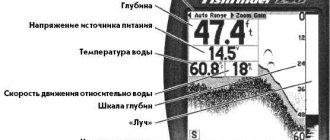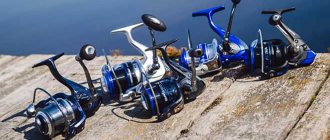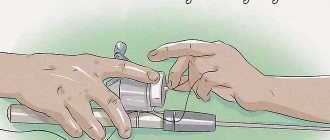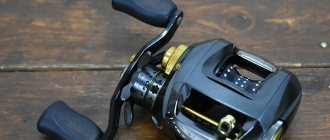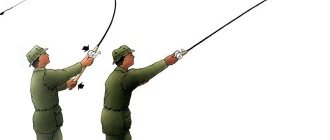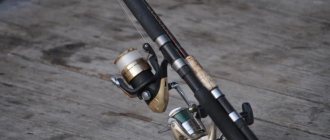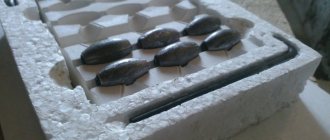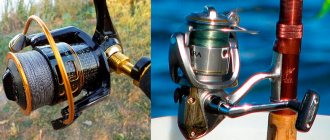When is a Bait Reel Required?
Even a novice fisherman can evaluate the pros and cons of a multiplier reel for a spinning rod. The complex design of a multi-reel for a spinning rod greatly affects prices, so low-priced models should be abandoned immediately. They will fail before they allow you to enjoy fishing.
This type of gear can be used for:
- trolling;
- casting from the shore;
- power fishing in a plumb line;
- fishing from a boat.
Multiplier reel
When choosing a baitcasting reel for a spinning rod, it is advisable to find a device with metal drive mechanism components. These last much longer.
What to look for when choosing?
Remember that this model has a complex design, which greatly affects the cost. Therefore, when choosing a multiplier, you should not purchase ultra-budget models, so as not to be disappointed.
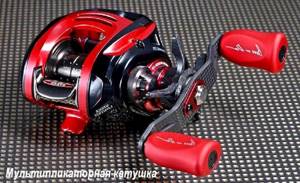
The main characteristics, requirements for the pond, spinning rod for a multiplier reel are indicated in the accompanying instructions. Make sure the model is suitable for the climate conditions of the region.
Find out what minimum fishing line diameter the multiplier can work with. The smaller the diameter specified, the more variations you will have for line selection. An incorrectly selected fishing line can get stuck in the spool and become damaged. The higher the gear ratio, the less the reel thrust. Values from 4.5 to 5.2 to 1 are suitable.
Low-profile, small-sized multipliers ensure high casting accuracy. When using braid, you should choose a model with a ceramic hole, thanks to which the cord will not fray.
Characteristics
The multiplier operates on the principle of inertia; its structure is somewhat similar to the functioning of a winch. There is a “trigger” located near the holder, which makes it easier to cast with a wrist. There is a bare blank underneath the spool where the ring finger usually sits. This ensures better sensitivity.
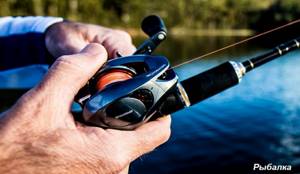
The angler can pass the braid through his fingers, which increases sensitivity. At every moment of time, the fisherman knows where the bait is, without even watching it, but by tactile sensations.
Be careful to size your line wisely if you plan to use this method, as too thin a line can cut your fingers.
Types of tactile bait control:
- control of the braid while the bait is falling. The cord passes between the thumb and forefinger;
- Line control all the time while fishing. This method often leads to cuts and is not suitable for everyone.
Application
Multipliers for spinning rods are used for casting fishing from the shore, from a boat, for power fishing in a plumb line or by trolling.
For the multiplier to work for a long time, you need to know the rules of its maintenance. Before installing a new model, you need to wipe all its elements with a flannel cloth moistened with kerosene. This is necessary to get rid of excess grease.
In order to set up the multiplier before fishing: unscrew the spool, wipe the ends and support bearings. If the design includes magnetic brakes, then excess must also be removed from them.
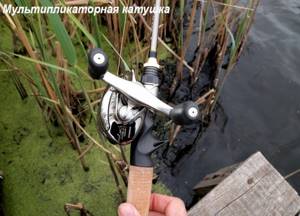
Wiping should be done after every fishing. If sand gets into the worm gear located under the line guide, it should be cleaned and then lubricated. After fishing, we loosen the clutch, and before starting fishing, set it to working condition.
Tips for a newbie:
- We select the braid depending on the weight of the bait. Braid with a diameter of less than 0.3 mm is effective for baits weighing up to 15 g. From 0.3 to 0.4 mm - 15−30 g; 0.4 mm - 30−40 g;
- The cord should be soft and round in shape. This is necessary to reduce windage, that is, increase the casting distance, as well as increase the sensitivity of the tackle;
- When choosing braid, give preference to aluminum oxide inserts. Sometimes monofilament lines are suitable.
Multiplier reel device
The animation type is simpler in design than the inertialess type. The fishing line is laid using a worm gear, and the load is transferred to the spool. The latter is usually cylindrical in shape. The gear transmission with the drive mechanism is responsible for the transfer of torque.
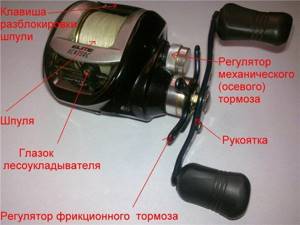
Multiplier reel device
To cast a spinning rod, you need to understand the operation of the braking system: the design of a multiplier reel for a spinning rod necessarily includes one of the options - magnetic, mechanical or combined.
Brake
To perform braking when casting occurs, a star-shaped clutch is installed in the reel. The multi-reel for spinning is equipped with metal plates and equipped with a braking system:
- centrifugal (mechanics) - six weights are provided that can be used separately or together;
- magnetic;
- combined.
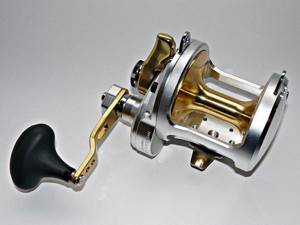
Thanks to one or another type of design, the inertia of the drum during the casting process is reduced. Magnetic TC is suitable for fishing with light baits when the load is light.
An axial brake is also provided. It works when the bait splashes down.
Location of multiplier handles
Multi-reels are available with both right-hand and left-hand handles. They do not differ too much from each other, but it is advisable to assemble rods with different types so that the load on the hands is even.
Right-hand multipliers will be appreciated by anglers who have already used inertial spinning rods. The cast is made with the right hand, then the form is transferred to the left, after which the retrieve is performed.
Left-handed ones are suitable for those who decide to switch from inertia-free ones. There is no need to move the rod here.
Power
Each manufacturer puts information on the body that tells you what load and line diameter the device is designed for. Casting a spinning rod with a multiplier reel without complying with these conditions is fraught with line jams and other unpleasant moments.
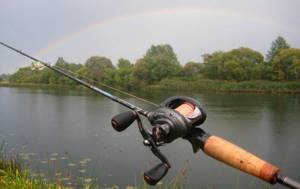
Spinning rod with multiplier reel
The power of the gear is determined by the number of drum revolutions per turn of the handle - the gear ratio. If it is small (up to 4.8), then the reel will be more powerful, and the speed of reeling in the line will be lower.
Features of the line laying machine
The fishing line is wound in a helical manner, the layer runs from cheek to cheek. The mechanism can be equipped with a ceramic eye or a wire fork. For monofilament fishing line, both options are used, for braided line only the first one is used.
In order not to lose casting range, the line guide is removed and the process is adjusted with your fingers. Some models have the ability to turn off the stacker without dismantling it.
It is important to ensure that the mechanism is located correctly - in the center of the drum.
Device Features
In general, the design of a multiplier reel differs significantly from both “meat grinders” and old inertial ones. Both “soap dishes” and “barrels” are similar in terms of general design. A metal (in the vast majority of cases) spool to which the load from a cord or fishing line is transferred, fixed inside a metal or plastic case.
These reels have two devices that prevent the line from tangling during casting and the formation of beards: a mechanical brake, and, depending on the specific model, a magnetic or centrifugal one. Both devices prevent beard formation, but do so at different points in the cast, and both require adjustment.
The mechanical one is triggered when the bait already touches the water. The spool continues to rotate at this moment, and without a brake, a beard is almost guaranteed. Magnetic and centrifugal options are arranged somewhat differently. They are also adjusted to the weight of the baits, but they work at the moment of casting, since it is during casting that the drum rotates at a very high speed, which is fraught with unpleasant consequences.
It is the adjustment of the multiplier reel, which is necessary for different weights of bait, that often scares off novice anglers.
Setting up the multiplier
To use a baitcasting reel for a spinning rod, you will need to spend time setting it up correctly. If a centrifugal brake is used, it is recommended to leave 1-2 weights to start with. This way the cast will be as far as possible without running the spool.
The main brake needs to be set as follows:
- Mount the reel on the rod.
- Hang the bait of the desired weight and size.
- Adjust the brake so that after a slight swing the bait drops 30-40 cm.
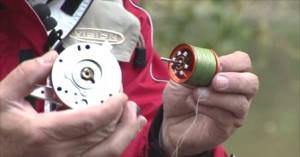
Thanks to this, casting will take place without tangling the line and dashing.
It is important to follow the manufacturer's instructions when choosing the thickness of the gear. Otherwise, the increased load may damage the mechanism. It is not recommended to tighten the friction brake.
How to care for a cartoon
Before using a baitcasting reel for a spinning rod, you need to do some preparation. Typically, drive mechanisms are heavily lubricated for long-term storage. Therefore it is required:
- Unscrew the fasteners to remove the spool.
- Remove the element and find the bearings on it.
- Wipe their surface with a rag soaked in kerosene.
- Treat parts that come into contact during rotation in the same way.
- Remove excess lubricant from the brake system.
After fishing, spinning will also require attention. The worm gear should be cleaned of any sand and dirt that may have entered it so as not to cause excessive wear. They check for cleanliness and line laying.
Moving parts will need to be lubricated from time to time. It is advisable to choose branded formulations designed for this.
It is recommended to loosen the clutch after fishing - fluoroplastic plates have memory, and when tightened they gradually lose the necessary characteristics.
Care and preparation
Regular maintenance of the product guarantees long and reliable operation of the multi. As a rule, at the end of the hunting period or the beginning of a new fishing season, the gears and brake control systems are cleaned and lubricated. For lubrication, mineral or synthetic substances are purchased that reduce friction and help protect parts of transmission mechanisms from abrasion and corrosion.
For these purposes, you will have to open the multiplier housing and apply lubricant to the joints. If a fisherman is unsure of his ability to carry out these manipulations, we advise you to contact service centers for servicing mechanisms, of which there are more and more, especially in large cities. After each fishing, it is enough to wipe the body of the product from dirt and moisture, subsequently storing the cartoons at room temperatures with low humidity.
Preparing the device for work involves correctly winding the main cord, for which a backing or backing is sometimes used, as well as setting up the braking systems according to parameters corresponding to the breaking loads of the fishing line and the expected forces at the moment of retrieving the caught trophy, which will directly depend on its size and resistance force .
How to cast a spinning rod with a multi-reel
A video on using a baitcasting reel for a spinning rod helps beginners understand how to cast this type of fishing gear.
To prevent the fishing line from getting tangled, you need to rely on some principles:
- the swing and cast are performed smoothly so that the spool does not develop additional acceleration;
- during unwinding, hold the bobbin with your finger;
- for long-distance casting, the bait is lowered from the tip of the spinning rod by at least 40 cm so that the line is stretched and the load is accelerated.
Mastering the technique is not difficult if you are careful.
Advantages and disadvantages of a multiplier reel
The pros and cons of a multiplier reel for spinning rods are worth considering in detail.
Pros:
- greater sensitivity to bites;
- casting range does not depend on the choice of fishing line thickness;
- The weight of the set is small - no more than 300 g;
- low landing of the rings, close location of the spool to the blank;
- thanks to the design, the line does not twist;
- suitable for fishing with wobblers;
- allows you to use baits of different weights.
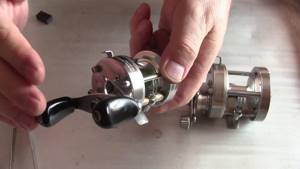
Cons:
- you will have to first master the casting technique;
- winding onto the spool is slower than when using a spinning reel;
- you will need to adjust the brakes;
- the cost is quite high;
- using ultralight bait is not always effective;
- not suitable for fishing in winter.
The main advantage of multipliers is the ability to use impressive bait and high casting accuracy.
Coil shape
Choosing a baitcasting reel begins with choosing its shape. There are two main options here:
- “barrel”, the shape of which is closer to cylindrical;
- a low-profile point-and-shoot reel, a more compact reel whose nickname given by anglers fairly accurately describes its appearance.
Previously, it was believed that the first option was more powerful, designed to work with the strongest and thickest fishing lines, while “soap dishes” were considered to be the more fragile “light” version. However, over time, the model ranges of both forms have expanded significantly, so that now many manufacturers can see the exact opposite picture - powerful low-profile models and lightweight barrels.
Different models differ in the location of the handle - it can be on the right or left. How to choose a baitcasting reel based on this criterion? Everything is quite simple here. It is believed that left-handed reels appeared due to the large number of anglers accustomed to inertia-free reels. The fact is that fishing with inertia-free fishing does not involve shifting the spinning rod from the right hand to the left, as had to be done with inertial devices.
Being a development of inertial action, the multis also inherited the position of the handle, which a number of anglers found not very convenient. In response to demand, left-handed devices appeared, in order to master fishing, you did not need to relearn how to transfer the form from hand to hand. Based on this, there are three options:
- If the angler is used to “meat grinders”, the better choice would be the more familiar left handle position.
Photo 1. For those accustomed to “meat grinders” - the handle is on the left. - For those who used mainly old inertial coils, right-handed models are more suitable.
- Anglers who have decided to master spinning fishing with a multiplier can take any option, although left-sided models are still somewhat better - there are fewer unnecessary movements during which you can miss a bite.
Attention! When fishing for a long time, it’s a good idea to have two rods with different options for positioning the handle on the reel - using them in turn, you can rest your tired hand without stopping fishing. This way, long-term fishing with a baitcasting reel will be more comfortable.
Which reels are better: multiplier or spinning reels?
The table helps to compare multis and spinning reels:
| Cartoon type | Inertialess type |
| For medium and large production | For small and medium fish |
| The brake system has to be adjusted frequently | No need to spend a lot of time on the brakes |
| The mechanism is lightweight | Significantly heavier than the cartoon |
| Requires additional training | Suitable for beginners |
| To load both hands equally, you need two rods | The handle adapts to your hand |
| Needs a certain type of rod | Universal |
